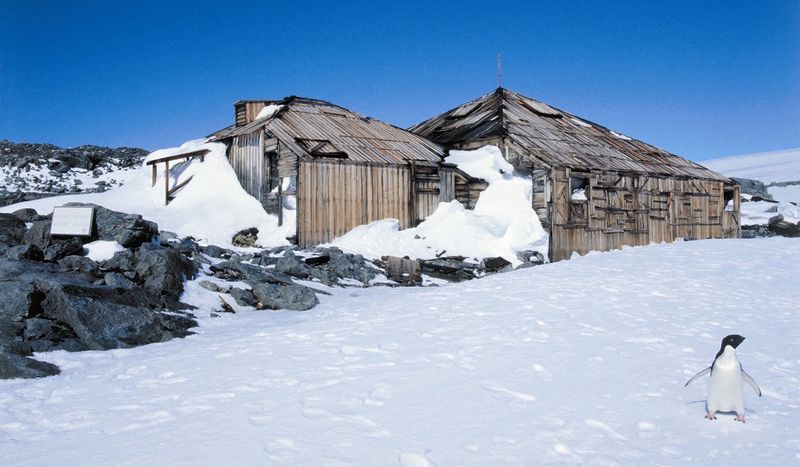Sir Douglas Mawson was an Australian geologist, mining engineer, academic, leader, explorer, and survivor who placed Australia firmly on the Antarctic map. Mawson was a key expedition leader during the heroic age of Antarctic exploration, alongside Roald Amundsen and Ernest Shackleton. Born in 1882, Mawson moved to Australia as a toddler and studied geology and engineering at the University of Sydney.
We named our newest small ship after this legendary Australian geologist and explorer because we believe it embodies Mawson’s pioneering spirit and is designed for global discovery. Read on to discover Sir Douglas Mawson’s Antarctic journey, from his first expedition with Shackleton to leading the Australasian Antarctic Expedition and how his legacy has shaped Australia’s Antarctic program.

Mawson's First Expedition to Antarctica
Mawson’s first visit to Antarctica was with the British explorer Ernest Shackleton who led the British Antarctic Expedition of 1907-1909. This journey marked Mawson’s introduction to the icy continent, as Shackleton’s crew achieved milestones such as ascending Mt Erebus and reaching the South Magnetic Pole.
Declining an invitation to join British Polar explorer Robert Falcon Scott’s South Pole conquest, Mawson organised his own expedition, the Australasian Antarctic Expedition (AAE) of 1911-14. He wanted to establish Australia’s presence in Antarctica on his own terms.
Australasian Antarctic Expedition
With an impressive ability to raise funds, alongside a desire to advance scientific knowledge, Mawson got the go-ahead for an Australian-led Antarctic research expedition. The 1911-1914 trip gained Mawson recognition, though it came at an enormous price.
Setting sail from Hobart in 1911 aboard the Aurora, a wooden vessel procured for the expedition, Mawson led Australia’s maiden large-scale scientific foray into Antarctica. Despite high expectations, the journey ended in tragedy, with Mawson emerging as one of the few survivors. Nevertheless, the expedition is still considered one of the most successful scientific Antarctic expeditions, as it lay the groundwork for Australia’s territorial claims.
The Australasian Antarctic Expedition’s tragedy occurred in 1912, when Douglas Mawson, Belgrave Ninnis, and Xavier Mertz set off with a team of sledge dogs to explore the region. Close to 500 kilometres from their Cape Denison base, an unexpected crevasse swallowed Ninnis, six of the strongest dogs, most of the food, and the tour tent. Mertz’s demise from consuming toxic dog liver further compounded Mawson’s harrowing ordeal, culminating in his solitary return to base only to witness the relief ship departing, stranding him for an additional year in Antarctica’s treacherous conditions.
Upon his return to Hobart in 1914, Mawson’s tale of survival eclipsed the expedition’s scientific gains in public perception. His indomitable spirit amid adversity earned him acclaim and a knighthood, solidifying his status as a legendary Antarctic figure.

Mawson's Antarctic Legacy
Mawson’s 1929 to 1931 expedition traversed the coast of East Antarctica and led to the 1933 claiming of land that is now the Australian Antarctic Territory. That is now the largest claim in Antarctica, approximately 42% of the continent almost the size of the Australian mainland itself.
Until his passing in 1958, Mawson remained instrumental in shaping Australia’s Antarctic program, laying the foundation for future exploration and scientific endeavours. Mining engineer, geologist, scientist, expedition leader, explorer, survivor, family man, visionary – Mawson left behind a story unmatched in Australian Antarctic history.
Mawson’s Huts
The enduring legacy of Mawson’s pioneering expeditions is encapsulated in the historic Mawson’s Huts at Cape Denison, Commonwealth Bay. These Baltic Pine shelters, despite enduring severe conditions, served as vital bases for scientific inquiry during the Australasian Antarctic Expedition (AAE) of 1911-14. Managed by the Mawson’s Hut Foundation, these huts provide a window into the Heroic Era of Antarctic exploration.
Sir Douglas Mawson’s contributions to Antarctic exploration and scientific research are unparalleled. From pioneering expeditions to securing Australia’s territorial claim, his legacy continues to inspire future generations of explorers. The preservation of Mawson’s Huts stands as a tribute to his enduring impact on Antarctic history.

Mawson's Hut Foundation
If you’d like to honour Mawson’s legacy, consider donating to the Mawson’s Huts Foundation. Dedicated to conserving Australia’s Antarctic heritage and preserving Mawson’s historic huts, the foundation strives to inspire current and future generations by safeguarding the legacy of Sir Douglas Mawson’s expeditions, alongside those of other Antarctic pioneers, and preserving Australia’s Antarctic heritage.
Be among the first to experience our newest small ship
The Douglas Mawson’s inaugural season will mark Aurora Expeditions’ return to East Antarctica for the first time in 13 years, with new itineraries to include a Mawson’s Antarctica voyage to East Antarctica in honour of the ship’s namesake, departing from Hobart, a semi-circumnavigation of Antarctica, and immersive explorations of the Subantarctic Islands. We’ve handpicked some of our favourite voyages below, or you can see the full range of itineraries onboard the Douglas Mawson here.
Mawson's Antarctica
Expedition
Welcome to Aurora Expeditions’ Mawson’s Antarctica expedition, sailing on the Douglas Mawson!Retrace the historic voyage of Sir Douglas Mawson’s Australasian Antarctic Expedition (AAE) and experience the grandeur of remote East...
24 Days
From USD $25,196.00/pp
Coastal Tasmania: Untamed Wilderness
Discovery
Revel in the opportunity to tread some of Tasmania’s greatest coastal tracks while you circumnavigate this island state by sea. Land on remote pristine beaches; trek through coastal heath, buttongrass...
12 Days
From AUD $12,316.00/pp
Subantarctic Discovery
Expedition
Welcome to Aurora Expeditions’ Subantarctic Discovery expedition. Discover the primordial beauty of the UNESCO World Heritage listed Australian and New Zealand Subantarctic Islands on this in-depth exploration of a most rugged...
15 Days
From USD $12,556.00/pp

